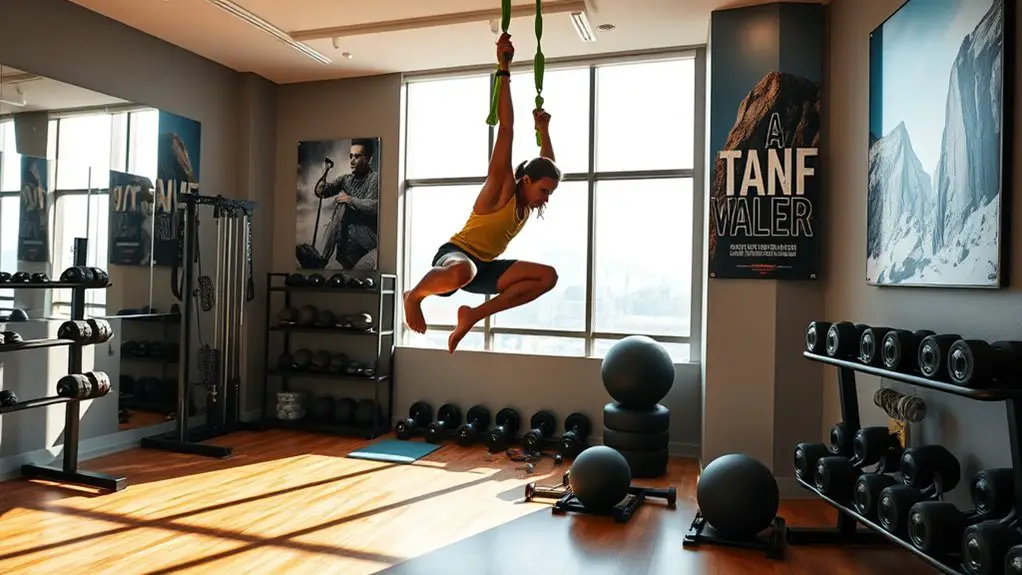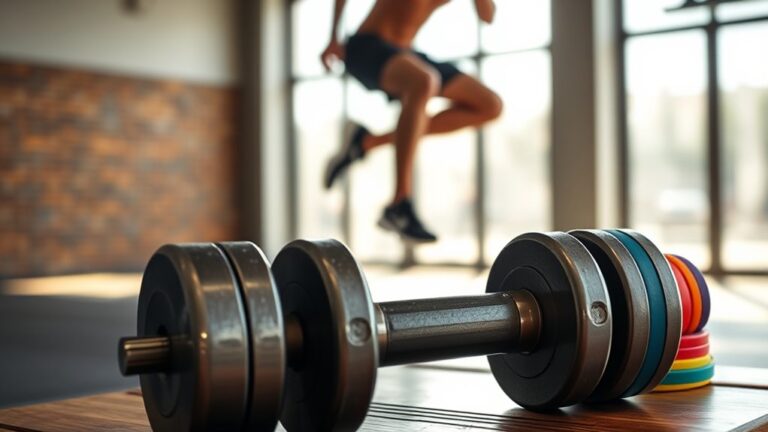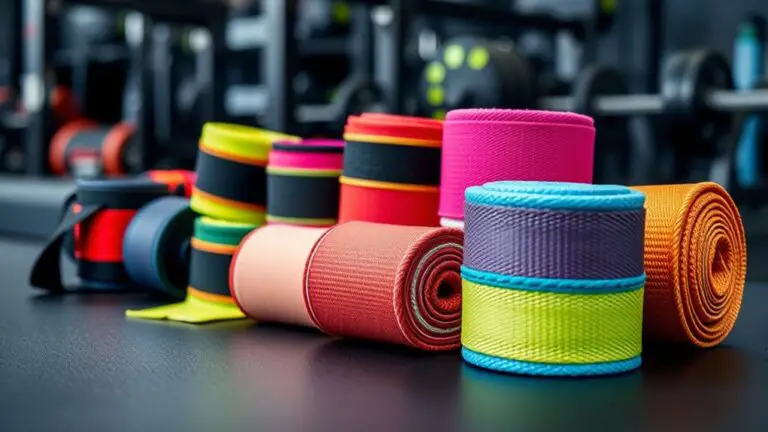The Best Gym Workouts for Rock Climbing Strength

To build rock climbing strength effectively, focus on core strengthening exercises like planks and hanging leg raises. Incorporate upper body workouts, including pull-up variations and shoulder stability exercises. Don’t neglect your lower body; squats and deadlifts enhance power and stability. Also, add flexibility routines and dynamic stretching to prevent injuries. Finally, integrate endurance training with interval sessions on the climbing wall. There’s a wealth of effective techniques and strategies to explore for ideal climbing performance.
Core Strengthening Exercises

To build a solid foundation for rock climbing, you can’t overlook core strengthening exercises. A strong core not only enhances your climbing performance but also prevents injuries. One effective method is incorporating plank variations into your routine. Standard planks engage your entire core, but you can amp up the challenge with side planks or plank rotations. These variations help develop stability and balance, essential for maintaining body control on the wall.
Using a stability ball can further elevate your core workouts. Try stability ball rollouts or wall passes to engage your abs dynamically. The instability forces your core muscles to work harder, enhancing strength and coordination. Additionally, combining these exercises with traditional moves, like hanging leg raises, will round out your core training. Make these core exercises a regular part of your routine, and you’ll notice an improvement in your climbing endurance and overall body awareness. It’s also crucial to consult a doctor if you experience any pain during these exercises to ensure you avoid exacerbating any potential injuries.
Upper Body Workouts for Climbers
To excel in rock climbing, you need a strong upper body, and focusing on pull-up variations is a great place to start. Incorporating effective push-up techniques will not only enhance your pushing strength but also improve stability. Don’t overlook targeted shoulder strengthening exercises, as they’re essential for maintaining balance and preventing injuries during your climbs.
Essential Pull-Up Variations
Pull-ups are a fundamental exercise for climbers, providing essential strength and endurance for tackling challenging routes. To maximize your training, incorporate these pull-up variations that enhance dynamic grip and explosive strength.
| Pull-Up Variation | Benefits |
|---|---|
| Standard Pull-Ups | Builds foundational strength |
| Wide Grip Pull-Ups | Targets lats and back muscles |
| Archer Pull-Ups | Improves unilateral strength |
| Explosive Pull-Ups | Develops power for dynamic moves |
| L-Sit Pull-Ups | Engages core for stability |
Effective Push-Up Techniques
Building upper body strength is just as important as mastering pull-ups when it comes to climbing performance. Effective push-up techniques can enhance your climbing by improving muscle endurance and stability. Start with basic push-up progressions, like incline and standard push-ups, to build a solid foundation. Once you’re comfortable, incorporate dynamic push-up variations, such as clapping push-ups or staggered hand push-ups, to increase intensity and engage different muscle groups. Focus on maintaining proper form: keep your core tight, back straight, and elbows at a 45-degree angle. As you progress, challenge yourself with explosive movements that mimic the demands of climbing. By consistently integrating these techniques, you’ll develop the upper body strength necessary for tackling more challenging climbs.
Targeted Shoulder Strengthening
Shoulders play an essential role in climbing, making targeted strengthening exercises important for enhancing your performance. A strong rotator cuff is critical for maintaining shoulder stability during dynamic movements on the wall. Incorporate exercises like external rotations, band pull-aparts, and overhead presses to build strength. Focus on controlled motions to engage the rotator cuff effectively, preventing injuries and ensuring your shoulders can withstand the demands of climbing. Don’t overlook the importance of scapular stability; exercises like scapular push-ups and wall slides can greatly enhance your overall shoulder function. By dedicating time to these targeted shoulder workouts, you’ll not only improve your climbing ability but also increase your resilience against potential injuries, keeping you on the wall longer and stronger.
Lower Body Strength Training
To excel in rock climbing, you can’t overlook the importance of lower body strength training. Incorporating squats, lunges, and deadlifts into your routine builds the power, stability, and overall strength you need for those challenging ascents. Let’s explore how each of these exercises can enhance your climbing performance. Additionally, proper form and technique during exercises such as these is crucial to minimize injury risk and enhance overall performance.
Squats for Power
Squats release your lower body’s potential, making them a cornerstone of any strength training regimen, especially for rock climbers. By incorporating squat variations, like front squats and jump squats, you can target different muscle groups and enhance your explosive power. These movements not only strengthen your quads, hamstrings, and glutes but also improve your stability and balance—key elements for climbing. For maximum benefit, focus on proper form and progressively increase your weight. Aim for low-rep, high-intensity sets to build that explosive strength essential for powerful moves on the wall. Integrating squats into your workout routine will equip you with the strength needed to conquer challenging climbs and improve your overall climbing performance.
Lunges for Stability
Lunges are an essential exercise for enhancing stability and strength in your lower body, making them particularly beneficial for rock climbers. By incorporating various lunge variations, you can target different muscle groups and improve your balance. Start with basic forward lunges, then progress to reverse lunges and lateral lunges to challenge your stability further. These stability exercises help develop the coordination and strength needed to maintain body control on challenging routes. You can also add weights or perform walking lunges for increased intensity. Remember to focus on form; keep your front knee aligned with your ankle and your core engaged. Incorporating lunges into your routine will enhance your climbing performance and reduce the risk of injury.
Deadlifts for Strength
Deadlifts pack a powerful punch when it comes to building lower body strength, making them a must-have in any rock climber’s workout routine. Utilizing proper powerlifting techniques is essential to maximize the benefits and minimize the risk of injury. Incorporate various deadlift variations, such as sumo or Romanian deadlifts, to target different muscle groups and keep your workouts fresh.
| Deadlift Variation | Target Muscles | Benefits |
|---|---|---|
| Conventional | Hamstrings, Back | Full-body strength boost |
| Sumo | Inner Thighs | Improved hip mobility |
| Romanian | Hamstrings, Glutes | Enhanced posterior chain strength |
Integrating deadlifts into your regimen can greatly enhance your climbing performance by strengthening your legs and core.
Flexibility and Mobility Routines
While strength is essential for rock climbing, flexibility and mobility are equally important for enhancing your performance and preventing injuries. Incorporating dynamic stretches into your warm-up routine can greatly improve your range of motion, allowing for better foot placements and body positioning on the wall. Focus on movements like leg swings, arm circles, and torso twists to activate your muscles and joints.
Additionally, foam rolling is a fantastic tool for releasing tightness in your muscles, particularly in areas like your hips and shoulders. Spend a few minutes rolling out these muscle groups before and after your climbing sessions to enhance recovery and maintain ideal flexibility.
Consider dedicating time to static stretches post-workout, focusing on your hamstrings, quadriceps, and back. This combination of dynamic stretching and foam rolling will help you maintain the flexibility needed to tackle challenging routes while reducing the risk of injury.
Endurance Training for Climbers

To excel in rock climbing, you need more than just brute strength; developing endurance is essential for tackling long routes and maintaining performance as fatigue sets in. To boost your climbing stamina, incorporate specific endurance techniques into your training. Start with interval training on a climbing wall, where you climb for a set time, rest briefly, and repeat. This simulates the demands of long climbs and builds your aerobic capacity.
You can also add traversing drills, focusing on continuous movement without excessive rests. Aim for longer sessions at lower intensity to enhance your muscular endurance. Additionally, consider using a campus board or a fingerboard for targeted grip strength sessions that maintain intensity over time.
Recovery and Injury Prevention Techniques
Since climbing places substantial stress on your body, prioritizing recovery and injury prevention techniques is vital for long-term performance and health. Incorporating active recovery into your routine can greatly enhance your recovery process. This means engaging in low-intensity activities like yoga, swimming, or light cycling, which promote blood flow and reduce muscle soreness.
To prevent injuries, focus on strengthening your stabilizer muscles through targeted exercises. Implementing proper warm-up routines and cool-down stretches will also help prepare your body and alleviate tension post-workout. Don’t overlook the importance of rest days; your muscles need time to repair.
Additionally, listen to your body: if you feel pain or fatigue, it’s important to scale back and allow for adequate recuperation. By integrating these recovery and injury prevention techniques, you’ll not only enhance your climbing performance but also guarantee your body remains healthy and resilient for years to come.
Frequently Asked Questions
How Often Should I Train for Optimal Climbing Performance?
To optimize your climbing performance, you should aim for a balanced training frequency. Training three to four times a week is effective, allowing your body to adapt while ensuring proper recovery. Don’t underestimate recovery days; they’re essential for muscle repair and strength gains. Listen to your body—if you’re feeling fatigued, consider adjusting your schedule. A well-structured plan that includes climbing sessions, strength training, and rest will help you reach your climbing goals efficiently.
What Is the Best Time of Day to Work Out?
The best time of day to work out really depends on your personal schedule and energy levels. Morning workouts can boost your metabolism and keep you energized throughout the day, while evening sessions might suit you if you feel stronger later on. It’s important to listen to your body; some find they perform better in the morning, while others excel in the evening. Ultimately, consistency and finding what feels right for you are key.
Should I Focus on Strength or Endurance First?
When deciding whether to focus on strength or endurance training first, it often depends on your specific goals. If you’re aiming for overall strength and power, prioritize strength training to build a solid foundation. However, if your goal’s more about stamina for prolonged activities, start with endurance training. Balancing both is essential, but establishing your primary focus will help you create a more effective training plan tailored to your needs.
Can I Incorporate Climbing Into My Gym Workouts?
Absolutely, you can incorporate climbing into your gym workouts! By using gym equipment like a campus board or a hangboard, you can enhance your climbing techniques effectively. Focus on drills that mimic climbing movements, such as pull-ups or lock-offs, to build strength. You could also integrate bouldering sessions into your routine for endurance. Just make sure to balance your climbing with strength training to prevent overuse injuries and promote overall fitness.
How Do I Track My Progress Effectively?
To track your progress effectively, start by establishing clear progress metrics. This might include tracking your climbing grades, workout intensity, or endurance levels. Utilize training logs—whether digital or paper—to record your workouts and any changes in performance. Regularly review these logs to identify trends, strengths, and areas needing improvement. By consistently documenting your progress, you’ll stay motivated and focused on your goals, making adjustments as necessary for ideal results.





